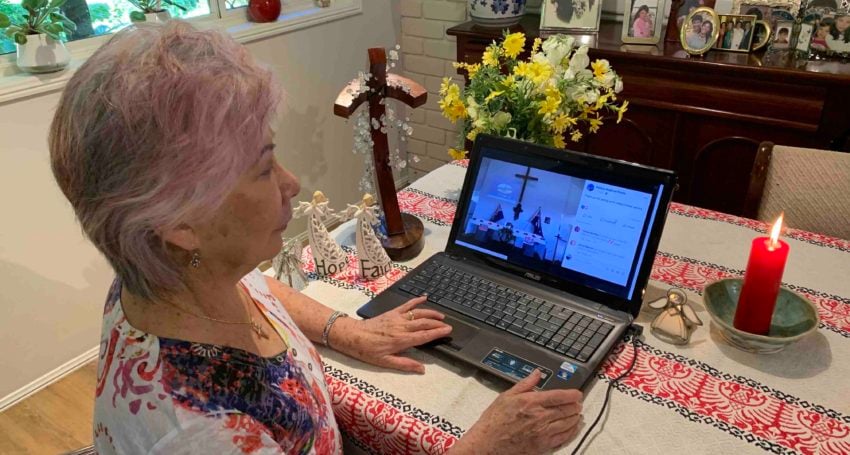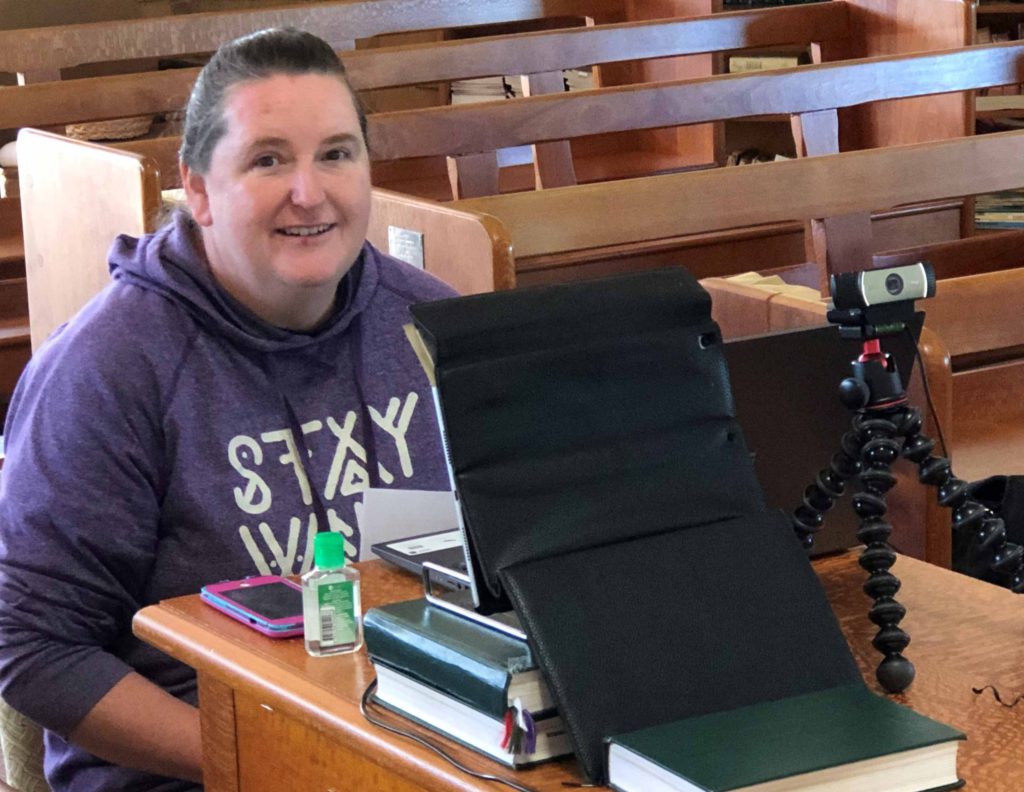Eucharistic companions on a digital journey
Features
“Digital church has been a reality for many years, but the concept of a live-streamed Eucharist requires some theological and pastoral reflection,” says Fr Jim McPherson

After vestry prayers for the three of us robed for the impending Sunday service, we enter the sanctuary in the customary manner. I greet the techno-producer and, if there is one, the organist. They are the only others I can see in the church building; ‘digital church’ is being celebrated in an amazing variety of places. While I cannot see or hear our congregations, I still greet them via the camera in usual fashion with, “The Lord be with you”.

“Our ‘techy’ Cindy New at action station, ready for The Parish of Maleny’s Zoom Church this morning [3 May 2020]”
The building echoes audibly without physical bodies present to absorb the sound waves. I can hear the answering responses of my two robed assistants and the techy, but no one else.
Digital church has been a reality for many years, but the concept of a live-streamed Eucharist requires some theological and pastoral reflection.
Eucharist is a material sacrament of bread and wine, consecrated by prayer for the spiritual nourishment of the faithful. In a live-streamed Eucharist, only the celebrant, and perhaps those with direct physical access, can consume the consecrated elements.
Advertisement
Under normal circumstances, Communion is for sharing physically. Nevertheless, one of our binding historical formularies (Book of Common Prayer, 1662) made provision for such special circumstances as “times of plague”.*
The rubric declares that one of conscientious faith and spiritual thankfulness may receive the sacramental benefit “profitably to his soul’s health, although he do not receive the Sacrament with his mouth”.
This means that “in times of plague”, devout engagement in the Eucharistic rite online, as if physically present in the congregation, will by God’s grace provide the same sacramental benefit as if there present and receiving. In effect, the Eucharistic grace is still received by ‘going to church’ via digital means and participating devoutly – by ‘being church’ as faithfully as contingencies allow. I find this remarkably reassuring. A companion is one with whom you share bread, so this constitutes Eucharistic companionship.
There is another dimension at play, too. With a camera and tech person present, I feel like an actor on a set somewhat, speaking to the camera with words from a script, along with accompanying actions. That is the baptismal commissioning of every Christian: to be so comprehensively immersed by grace in the Gospel story, as to embody it authentically and credibly in the contemporary context of family, friends, workmates, sporting activities, whomever. All the baptised are commissioned actors, today’s gospel embodiments.
Related Story
 Features
Features
Zoom Church: discoveries and tips
Going physically to a church – dedicated space – highlights the difference between the everyday and the sacred. Church at home need not blur this distinction if your ‘venue’ is well-prepared and maintained. This could mean dedicating your own worship space, either for yourself alone or for all family members, in an area free from distractions like the noise of heavy traffic (if possible) and set up with Bible, Prayer Book, flowers, and comfortable seating. Some may like to use candles as well – dig a baptismal candle out of the drawer, maybe. You may not need a hymn book, because words will often be provided on the screen. Though if they are modernised and you prefer the old words, such as ‘Thee’ and ‘Thou’, you can sing them as loudly as you like at home without putting the rest of the congregation off.

Fr Jim McPherson presiding over The Parish of Maleny Eucharist via Zoom on Sunday 3 May 2020. Fr Jim suggests that churches provide the service and hymn words on a screen/wall for those joining in at home
As a priest, I find it strange to be addressing the camera in a church that echoes for lack of people present. Stranger still to have a power outage mid-sermon and having to wait until it is restored before resuming. But such things happen in gathered church buildings as well. A parishioner once collapsed in her pew during a service, so we called the ambulance; everyone went into a prayerful, if somewhat, anxious suspended animation. These are the exigencies of ‘real’ as well as ‘digital’ Eucharist.
I am confident the grace of God will see us through this awkwardly unfamiliar and challenging time. Let us learn from this, so we emerge the better for it. As will all those who engage with digital church, and find themselves so drawn in by grace, that they eventually yearn to meet any new faith companions face to face.
Top 10 tips for celebrating a live-streamed Eucharist:
- Priests and assistants are encouraged to engage in vestry prayers prior to the commencement of the service.
- Test the video quality and composition before live streaming.
- Test the audio before live streaming, especially given the tendency for churches to echo with few people in attendance.
- Email pew sheets to congregation members prior to the service.
- Reassure those in ‘digital attendance’ that they will receive the sacramental grace of the Eucharist as though they were physically consuming the consecrated host and wine.
- Provide the service and hymn words on the screen or white wall.
- Encourage your parishioners to set aside a special space, with a Bible, Prayer Book, flowers and candles.
- Ensure that any new faces are collectively welcomed during the service and that a regular parishioner connects with new congregation members following the service.
- Allow a fellowship time after the service for parishioners to chat, if appropriate for your congregation and if technologically enabled.
- Encourage congregation members to provide feedback and share ideas with you via email, Facebook messenger or phone.
Editor’s note: find out what ACSQ churches are offering live-streamed Eucharistic (and other worship) services by visiting the Anglican Church Southern Queensland website.
* In The Communion of the Sick, the rubric advises the priest to instruct the sick person who for “just impediment” (such as “extremity of sickness”) cannot receive the consecrated elements, that:
“…if he do truly repent him of his sins, and stedfastly believe that Jesus Christ hath suffered death upon the Cross for him, and shed his Blood for his redemption, earnestly remembering the benefits he hath thereby, and giving him hearty thanks therefore; he doth eat and drink the Body and Blood of our Saviour Christ profitably to his soul’s health, although he do not receive the Sacrament with his mouth.”
In other words, genuine faith and intention allow for a spiritual Communion with all the benefits of partaking of the consecrated elements, which would normally be the case except for the communicant’s present circumstances.





